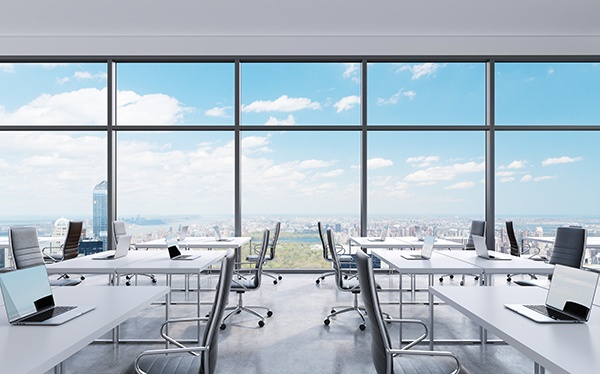
The ideal image of the perfect workplace is always shifting. Once, workplaces were mazes of private offices, with location, size and access to windows tied to a worker's rank. Then, workplaces became wide-open mazes of cubes, established by office furniture rather than by construction. These floor plans were cheap, but not cheerful. Today's perfect workplace is an amalgam of offices of the past with modern features that keep it flexible for the unforeseen changes that the future brings. So, what does the perfect workplace look like?
Completely Central
The locational aspect of corporate real estate strategy was once very simple - choose a downtown location. Then, companies all fled to suburban corporate campuses, leaving many downtowns quiet. Today, companies can locate just about anywhere they want. Downtowns are centrally located for public-transit using employees while suburban locations usually have the benefit of free parking. Companies don't have to be in major 24-hour downtown cities like San Francisco, Chicago or New York, either. Rogers, Arkansas is a retail hotbed thanks to Wal-Mart, Des Moines, Iowa is a banking and insurance center, Salt Lake City is a major tech destination and Alabama is seemingly the place to go build cars. Choosing a location today is about one thing: It needs to be centrally located and convenient to a company's employees and other stakeholders. A well-planned corporate real estate strategy envisions the location that best serves a company’s ability to thrive, regardless of its address.
Open and Closed Buildouts
The corporate real estate strategy for the ideal workplace buildout always changes. Because of fluctuating tastes in how a workplace should look, the modern paradigm of a flexible workplace makes perfect sense. While the perfect workplace is generally open to allow for better collaboration between employees, this cannot always be attainable. Some workers need private offices as part of their jobs. Others work best in wide-open areas that don't even have cubicle dividers, while others need a space, but not necessarily a completely private one.
The Benefits of Open Office Space
At the same time, the modern office has to accommodate a workforce whose size changes from day to day. Between workers that spend their time in the field, telecommuting employees that come into the office only occasionally and travelling workers that work from whatever city they find themselves, the same office could be empty or bursting at the gills on any given day.
Employees do different types of work depending on the needs of the company. One worker who spends all day Monday on the phone with a customer troubleshooting an issue could spend Tuesday working with an internal team brainstorming solutions, and Wednesday working feverishly to encapsulate those solutions in a spreadsheet or a block of programming code. With this in mind, the only suitable corporate real estate strategy is flexibility. The modern office space has offices, cubes and open areas. It has small conference rooms, and large ones. It should be able to serve the varying needs of the modern company.
Wires Everywhere... And Nowhere
IT has taken over the workplace, making essentially every worker a tech worker. While IT has simplified corporate real estate strategy in some ways, like allowing employees to work remotely without occupying space, it can complicate buildouts. While wireless networking best suits flexible working arrangements, the limited bandwidth and security considerations of wireless networks also keep wired networks in use.
Furthermore, the development of fiber-based 10-gigabit Ethernet also changes the nature of wiring. The workplace of the future will have copper and fiber networking ports readily available while also having comprehensive wireless coverage available.
As you narrow down decisions of how to optimize your corporate real estate strategy, it helps to realize that the perfect workplace isn’t an image, but rather a concept: flexibility. As employees needs change, technology advances and business growth fluctuates, it helps to have real estate that can adapt quickly. What does the perfect workplace look like to you? Let us know in a comment.
Other great commercial real estate articles:
Open Office Layout Drawbacks
Corporate Real Estate Strategy Tips
Commercial Lease Renewal Myths... Busted!
Six Amenities to Look for in Office Space
Subscribe to our blog for more great tips!!








